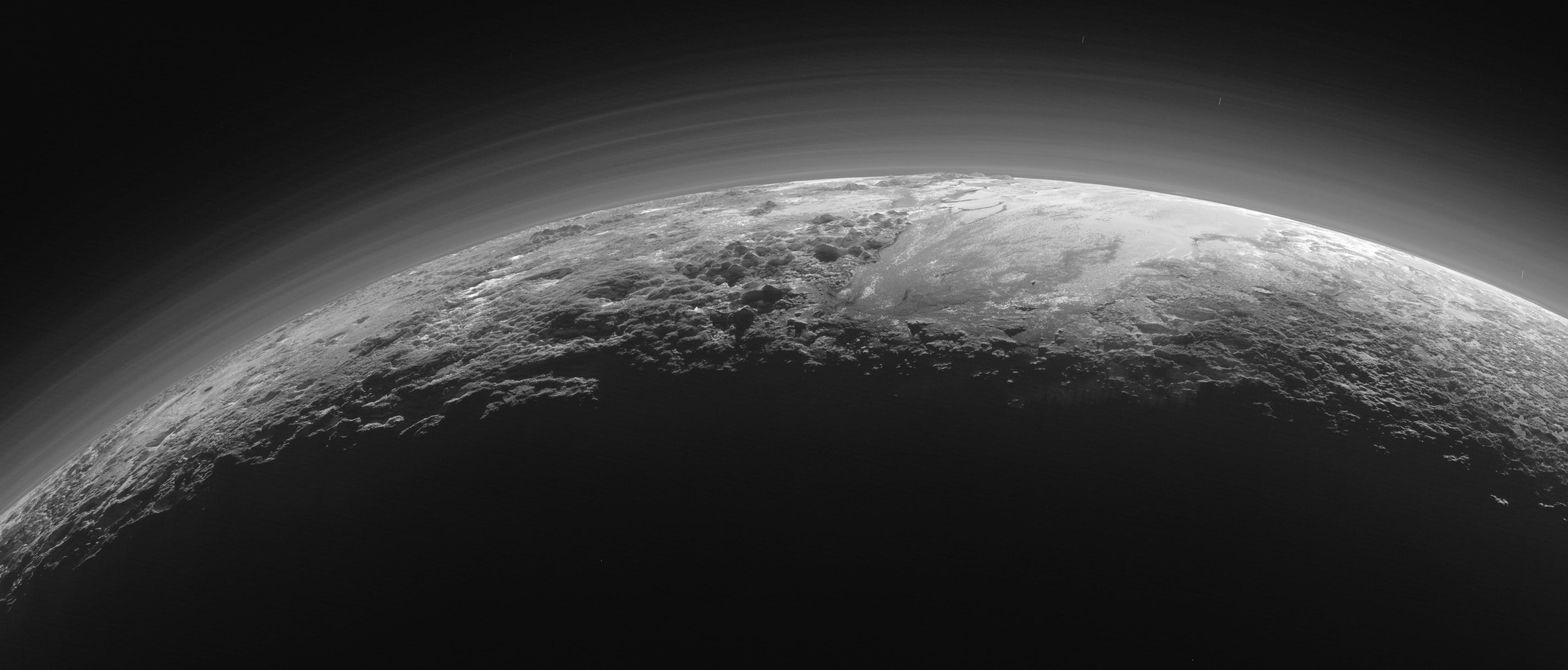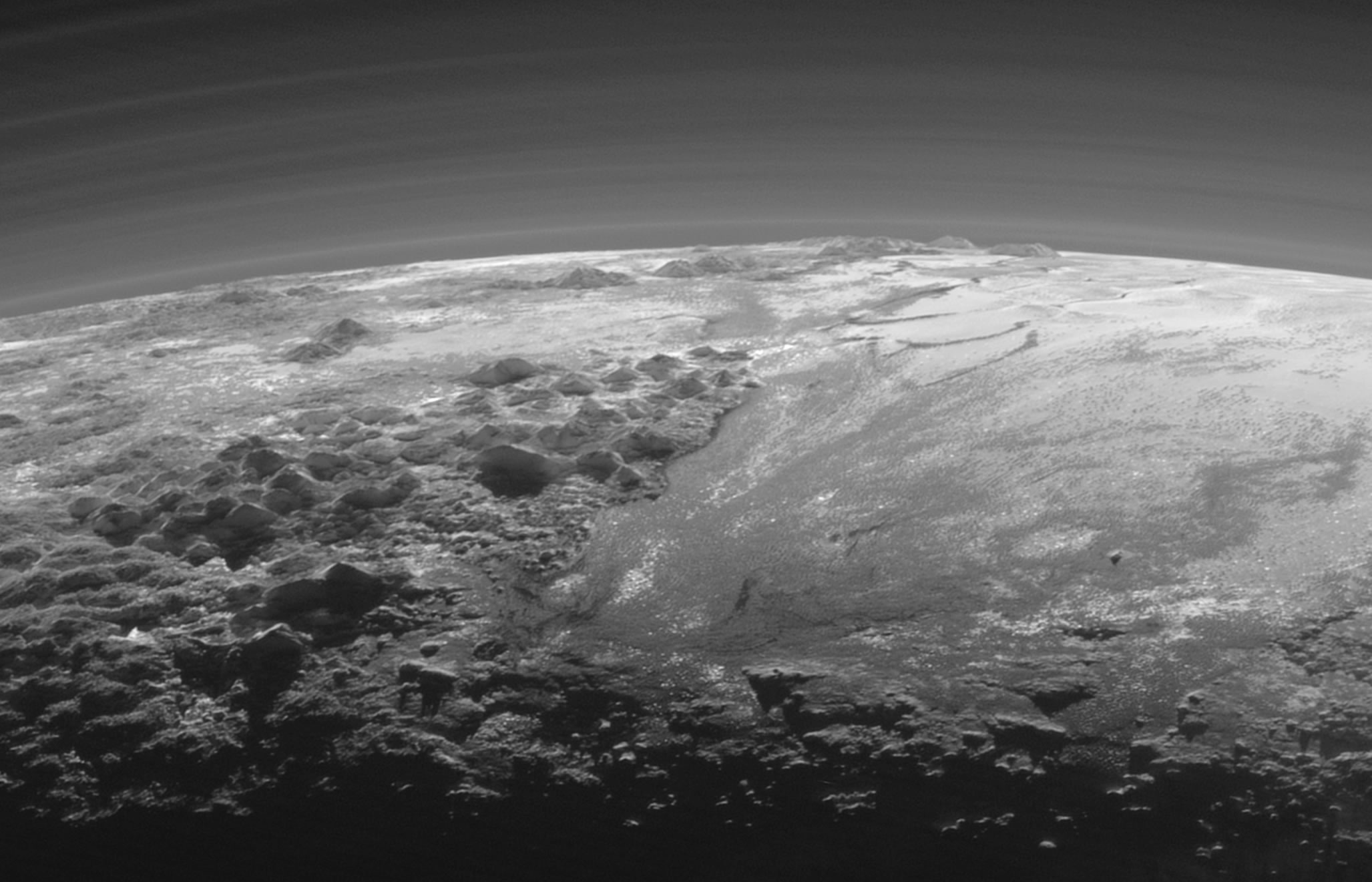There Are Good People in the World
Sometimes we lose sight of that.
Sometimes You Don't Need to Leave Earth…
…to go to another planet.





Discovered on one of my internet wanderings this morning, Panjin Red Beach is located in the north east of Beijing and is appropriately called this due to the seaweed which turns to a bright red colour in autumn. It has become known as the "Home of the Cranes" and is the home to 260 different types of birds, including the endangered Crown Canes and Blacak Beaked Gulls, and 399 different types of wild animals.





And the Hits Keep on Coming!
NASA's New Horizons spacecraft has returned the best color and the highest resolution images yet of Pluto's largest moon, Charon—and these pictures show a surprisingly complex and violent history.

At half the diameter of Pluto, Charon is the largest satellite relative to its planet in the solar system. Many New Horizons scientists expected Charon to be a monotonous, crater-battered world; instead, they're finding a landscape covered with mountains, canyons, landslides, surface-color variations and more.
"We thought the probability of seeing such interesting features on this satellite of a world at the far edge of our solar system was low," said Ross Beyer, an affiliate of the New Horizons Geology, Geophysics and Imaging (GGI) team from the SETI Institute and NASA Ames Research Center in Mountain View, California, "but I couldn't be more delighted with what we see."

This composite of enhanced color images of Pluto (lower right) and Charon (upper left), was taken by NASA's New Horizons spacecraft as it passed through the Pluto system on July 14, 2015. This image highlights the striking differences between Pluto and Charon. The color and brightness of both Pluto and Charon have been processed identically to allow direct comparison of their surface properties, and to highlight the similarity between Charon's polar red terrain and Pluto's equatorial red terrain. Pluto and Charon are shown with approximately correct relative sizes, but their true separation is not to scale. The image combines blue, red and infrared images taken by the spacecraft's Ralph/Multispectral Visual Imaging Camera (MVIC). Credits: NASA/JHUAPL/SwRI
High-resolution images of the Pluto-facing hemisphere of Charon, taken by New Horizons as the spacecraft sped through the Pluto system on July 14 and transmitted to Earth on Sept. 21, reveal details of a belt of fractures and canyons just north of the moon's equator. This great canyon system stretches more than 1,000 miles (1,600 kilometers) across the entire face of Charon and likely around onto Charon's far side. Four times as long as the Grand Canyon, and twice as deep in places, these faults and canyons indicate a titanic geological upheaval in Charon's past.
"It looks like the entire crust of Charon has been split open," said John Spencer, deputy lead for GGI at the Southwest Research Institute in Boulder, Colorado. "With respect to its size relative to Charon, this feature is much like the vast Valles Marineris canyon system on Mars."
Even higher-resolution Charon images and composition data are still to come as New Horizons transmits data, stored on its digital recorders, over the next year – and as that happens, "I predict Charon's story will become even more amazing!" said mission Project Scientist Hal Weaver, of the Johns Hopkins University Applied Physics Laboratory in Laurel, Maryland.
The New Horizons spacecraft is currently 3.1 billion miles (5 billion kilometers) from Earth, with all systems healthy and operating normally.
New Horizons is part of NASA's New Frontiers Program, managed by the agency's Marshall Space Flight Center in Huntsville, Alabama. APL designed, built, and operates the New Horizons spacecraft and manages the mission for NASA's Science Mission Directorate. SwRI leads the science mission, payload operations, and encounter science planning.
OH EM GEE
The really good pictures of Pluto from NASA's New Horizons probe are starting to trickle in, and they are fucking breathtaking.


 " alt="" />
" alt="" />



Mythopolis
Mythopolis from Alexandra Hetmerova on Vimeo.
Pluto Flyby
Amazing…and Tantalizing
While data and pictures will be downloading for the next sixteen months, NASA's New Horizons probe already provided humanity with some astoundingly tantalizing photos of Pluto and it's main moon, Charon.


What strikes me the most about the color photos of Pluto is the color. They look like antique tintype prints. Even when I see the planet with the dark grey Charon immediately next to it, I still have a hard time wrapping my head around the fact that this is the planet's actual color.
What's even more amazing to me is the fact that with the level of sunlight falling on these worlds and the speed at which New Horizons sped past that NASA was able to get any images whatsoever.
Science is cool.

And the fact that they can get closeups of the surface of this quality is nothing short of astounding—with even higher resolution images coming that will download over the coming months.

If Pluto weren't fascinating enough on it's own, Charton is revealing just as many surprises.

For example, how do you get a peak rising out of a circular depression? No one seems to know. What it looks like to me is that a space rock came in very, very slowly, and almost had a soft landing on an extremely plastic surface. Not traveling fast enough to form a traditional crater/ray structure, but fast enough to impact the surface and only slightly deform the surrounding terrain.

All I know is that after seeing these few images, it's obvious that humanity will have to return at some point for an even better look. I doubt it will happen in my lifetime, but it still fires the imagination—especially when you consider that we didn't get any sharp photos of Pluto's much more interesting face:

"Danny! I'm Coming!"
Absolutely amazing, and definitely worth 24 minutes of your time if you're a fan of The Shining.
Gigapixels of Andromeda
On January 5, NASA released an image of the Andromeda galaxy, our closest galactic neighbour, captured by the NASA/ESA Hubble Space Telescope. The full image is made up of 411 Hubble images, takes you through a 100 million stars and travels over more than 40,000 light years. Well, a section of it anyway.
Prepare to feel extremely tiny and insignificant (or just the opposite!) as you marvel at this fly-through video created by YouTuber daveachuk and make sure you stick around till the end. Seriously.
Desert Breath

Located near the Red Sea in El Gouna, Egypt, Desert Breath is an impossibly immense land art installation dug into the sands of the Sahara desert by the D.A.ST. Arteam back in 1997. The artwork was a collaborative effort spanning two years between installation artist Danae Stratou, industrial designer Alexandra Stratou, and architect Stella Constantinides, and was meant as an exploration of infinity against the backdrop of the largest African desert. Covering an area of about 1 million square feet (100,000 square meters) the piece involved the displacement of 280,000 square feet (8,000 square meters) of sand and the creation of a large central pool of water.





First Photos of One of the Solar System's Craziest Objects
In March 2004, the European Space Agency's Rosetta spacecraft left Earth in pursuit of comet 67P/Churyumov-Gerasimenko. Today, more than 10 years and four billion miles later, Rosetta became the first spacecraft in history to rendezvous with a comet. The probe is now soaring through space in tandem with its target—and the view is incredible.


In November, from a projected orbital distance of just 2.5 km, Rosetta will deposit a lander on the comet's surface—all this in preparation for 67P's closest pass of the Sun in more than six years. As it swings around our parent star, the mass of ice and dust will warm, shedding bits of itself along the way; Rosetta—and Philae, the lander—will have unprecedented front row seats to the show.
Mind. Blown.

Io Erupts
Nasa's NEW HORIZONS spacecraft, en route to a rendezvous with Pluto in 2015, captured this amazing video in 2007 of Io, Jupiter's third largest moon, in the midst of a monumental eruption occurring from the Tvashtar volcano on the moon's northern hemisphere.
Science is cool.
What Manner of Sorcery is This?


Synchronicity
I was at Einstein's the other day having lunch and slowly making my way through Walter Isaacson's biography of Steve Jobs. I was at the point in the book where Job was waxing poetic about his love of Bob Dylan's music and how he finally got to meet the man who so profoundly influenced him. I was immediately reminded of my dear friend Beth in Phoenix, who in her younger days actually dated Dylan for an extended period:
Me: "You should've seen my Mom's face when I brought home my first Bob Dylan record."
Beth: "You should've seen my Mom's face when I brought home Bob Dylan."
At that exact moment, one of Dylan's songs (I don't know which one; I recognize his voice but not his complete catalog) started playing over the sound system.
There is a lot about the nature of reality that we simply do not understand—and probably never will.
Despina, Moon of Neptune
From APOD:
Despina is a tiny moon of Neptune. A mere 148 kilometers across, diminutive Despina was discovered in 1989 in images from the Voyager 2 spacecraft taken during its encounter with the solar system's most distant gas giant planet. But looking through the Voyager 2 data 20 years later, amateur image processor and philosophy professor Ted Stryk discovered something no one had recognized before—images that show the shadow of Despina in transit across Neptune's blue cloud tops. His composite view of Despina and its shadow is composed of four archival frames taken on August 24, 1989, separated by nine minutes. Despina itself has been artificially brightened to make it easier to see. In ancient Greek mythology, Despina is a daughter of Poseidon, the Roman god Neptune.
Beauty in Darkness
Beauty in Darkness







Stars Bursting In The Night Sky
Australian photographer Lincoln Harris' collection Star Trails, surreal swirls in the sky created from a multitude of long-exposure shots and the effect of the Earth's rotation.
Two of My Favorite Things
What do you get when you combine Calvin & Hobbes with the wisdom of Dune?
Wondrous things, that's what:

Recipe
For those not wishing to contract salmonella.

Eggless Cookie Dough
(to eat, not to bake)
3/4 cup brown sugar
1/4 cup butter, softened
1/4 tsp vanilla
1/4 cup milk
1 cup flour
pinch of salt
1/2 cup chocolate chips
Mix together in a bowl, grab a spoon, and put on a movie.
Want!
These beauties were brought back from the dead.

Spacely Sprockets 2

1956. "General Motors Technical Center, Warren, Michigan. Design Center interior with stair in background. Eero Saarinen, architect."
Fasten Your Seat Belts
Amazing video of the Space Shuttle during launch, taken with cameras and mics mounted on the solid rocket boosters that propelled the shuttles into space. All the sound is from the actual camera microphones and has not been faked or replaced with foley artist sound.
More Mad Men!
Welcome to Spacely Sprockets!
Mad Men!
Who Needs Aliens?
When you have this rarely-seen-in-its-native-habitat majestic 8-foot long Oarfish?
I'm Ready For My Closeup, Mr. DeMille


Nom Nom Nom




Deep-Dish Chocolate Chip Cookie for One
Ingredients (1 serving)
- 1 Tbsp unsalted butter, at room temperature
- 1/2 Tbsp granulated sugar
- 1/2 Tbsp packed light brown sugar
- 1 Tbsp beaten egg (cover & chill remaining beaten egg for tomorrow's cookie cup… you will be making another one!)
- tiny splash pure vanilla extract
- 2 1/2 Tbsp flour
- 1/8 tsp baking soda
- tiny pinch salt
- heaping 1 Tbsp chocolate chips
Instructions
In a small ramekin or microwavable cup, combine softened butter and both sugars; stir well with a spoon. Stir in beaten egg and vanilla extract. Stir in flour, baking soda, and salt just until combined. Stir in chocolate chips.
Microwave on high for 35-40 seconds. Let cookie rest at room temperature for about 10 seconds before devouring.





